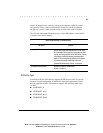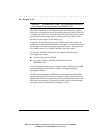
. . . . . . . . . . . . . . . . . . . . . . . . . . . . .
5-5
Compaq Netelligent 2724/2824 Dual-Speed Hub User Guide
Writer:
Chris Seiter
Project:
Compaq Netelligent 2724/2824 Dual-Speed Hub User Guide
Comments:
ile Name:
2824_5.DOC
Last Saved On:
06/25/97 5:32 PM
The hub’s IP frame type can be set by three different methods:
■
BOOTP Sends requests over ETHERNET_II and/or
ETHERNET_SNAP frame types, which you can configure, as needed.
The hub’s IP frame type is set to the frame type of the BOOTP response
(if it is received) and saved in non-volatile memory.
NOTE:
If the hub transmits BOOTP requests over two frame types, this
lengthens the time required to complete the BOOTP process.
■
SNMP If you set the frame type using SNMP over IP, you must set
the IP address using the cpqnIpAddr MIB variable. SNMP over IPX
does not require an IP address configuration.
■
VT100 You can set the hub’s IP frame type from the Management
Agent Configuration screen. The 2824 hub saves changes in non-volatile
memory.
NOTE:
If you are using Telnet or SNMP over IP, the hub must already have a
valid configuration for either its IP or SLIP interface.
To determine which IP frame type it will implement, the hub uses the following
priority scheme:
■
If a BOOTP response is received during the BOOTP process, uses the
frame type of the received packet
■
If no BOOTP response is received during the BOOTP process, uses the
frame type saved in non-volatile memory
■
If no value is stored in non-volatile memory, uses the default value of
ETHERNET_II
At any time after the initial BOOTP process, you can change the frame type
using VT100 or by setting the MIB object cpqnIpFrameType.


















